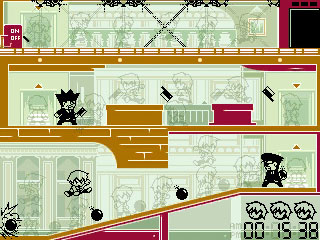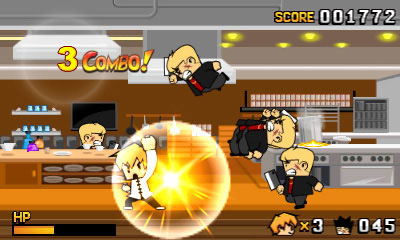Interesting takes on Game and Watch classics; Nice presentation
Repetitive brawler stages; bad boss fights; Unnecessary difficulty; Can essentially becoming a guessing game/reaction-time test
Before releasing Johnny Kung Fu, the team at UFO Interactive was responsible for creating two previous eShop games: Zombie Slayer Diox and Samurai Sword Destiny. These games both shared a similarity in that they were both very ambitious ideas, but ultimately fell flat in execution. Johnny Kung Fu, UFO Interactive’s latest eShop arrival, continues the trend by building a solid foundation of ideas, but failing to reach the game’s true potential.
Shortly after watching a crudely (which I assume was the targeted style) made cut-scene, you’ll lead Johnny on a quest to travel up the multiple floors of a skyscraper to save a damsel in distress. Each floor is represented on either the top screen or the bottom screen of the 3DS. The bottom screen levels will consist of ideas heavily influenced by Nintendo’s Game and Watch handhelds, which is something that the game lets you know right off the bat. Levels will include many takes on Game and Watch classics, such as the Donkey Kong inspired levels and a version of Ball, but instead of juggling balls, you’ll be juggling bombs (oh my!). The top screen will consist of several run-of-the-mill, 2D brawler stages that you’ve seen done better hundreds of times before– these are easily the game’s low points.

The levels represented on the bottom screen are based on Game & Watch games
With two different styles of game play comes two different graphical styles, and Johnny Kung Fu nails its style for the most part. The Game and Watch inspired games look great; there is a ton of detail to make the player really feel like they’re playing one of Nintendo’s old handhelds. Sadly, these stages are represented on the bottom screen, which means the 3D work is exclusive to the admittedly less interesting, more flash-game quality graphics of the (also less interesting) brawler levels. This is a shame, because I feel that the effect could have made the Game and Watch inspired levels all the more interesting to look at.
After all the praise for the Game and Watch levels’ appearance, you can only assume it plays just as well, right? Well, partially. The game plays pretty much exactly like one of the typical Game and Watch titles, but that isn’t exactly a compliment. Sure, for the first couple of floors, the idea is very novel, but once the game starts rapidly speeding up and you’re forced to play the games over and over again in higher and higher difficulties, the gameplay suffers by essentially becoming a reaction-time test rather than being a true challenge, and ultimately, the game falters because of it. This becomes extremely apparent in the stages where a countdown timer ticks down, and once it hits zero, the player and a computer opponent will receive a number above their heads, and depending on whether or not your number is higher than the computer’s, you must either dodge or attack. When the game begins to ramp up in difficulty, this stage essentially becomes a guessing game.

You’re going to get disappointed once you see that the game is switching to the top screen…
The spike in difficulty wouldn’t be all that bad had the game not included a one hour time limit to complete. In the beginning of every stage, the player has three lives to complete each level’s goal. If you run out of lives, you can either restart the entire game (no thank you!), or continue from where you left off. If you hit continue, the game takes away five minutes from your overall time, which doesn’t sound all that punishing, but in the later stages, you’ll be surprised at how fast those sixty minutes can quickly travel down to just five. Admittedly, I did want to try again after my first run, if only just to see if the game was actually possible. That feeling soon went away after about my fifth time trying to complete the game. I soon got even more annoyed at the difficulty, repetitive brawling stages, and the bosses that seemed to have way more health than needed. In summary, you will not want to play this game again once you beat it, or maybe even after just one or two attempts. Luckily, the game does separate some of the better stages into a separate mode that you can just play over and over again for high scores. I had some fun with this, but ultimately, I doubt that I’ll ever come back to it.
In the end, I was left with the feeling that Johnny Kung Fu was sold short of its true potential. The basic premise is good, the gameplay (well, half of the gameplay…) is spot on, but sadly, the game is hindered by an unnecessarily brutal spike in difficulty and a repetitive, unrewarding design that makes a game that was once unique and challenging, turn into to a bore of a reaction-time test.
Nintendojo was provided a copy of this game for review by a third party, though that does not affect our recommendation. For every review, Nintendojo uses a standard criteria.




 ShareThis
ShareThis






